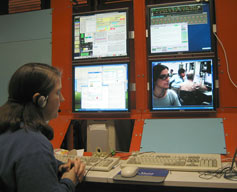
Handy Links
SLAC News Center
SLAC Today
- Subscribe
- Archives: Feb 2006-May 20, 2011
- Archives: May 23, 2011 and later
- Submit Feedback or Story Ideas
- About SLAC Today
SLAC News
Lab News
- Interactions
- Lightsources.org
- ILC NewsLine
- Int'l Science Grid This Week
- Fermilab Today
- Berkeley Lab News
- @brookhaven TODAY
- DOE Pulse
- CERN Courier
- DESY inForm
- US / LHC
SLAC Links
- Emergency
- Safety
- Policy Repository
- Site Entry Form

- Site Maps
- M & O Review
- Computing Status & Calendar
- SLAC Colloquium
- SLACspeak
- SLACspace
- SLAC Logo
- Café Menu
- Flea Market
- Web E-mail
- Marguerite Shuttle
- Discount Commuter Passes
-
Award Reporting Form
- SPIRES
- SciDoc
- Activity Groups
- Library
Stanford
Around the Bay
Strong Focus on Test Beams
 On the opposite rim of the Pacific Ocean, a group of SLAC physicists are part of the international team helping to expand the
Accelerator Test Facility (ATF) at the Japanese lab KEK.
On the opposite rim of the Pacific Ocean, a group of SLAC physicists are part of the international team helping to expand the
Accelerator Test Facility (ATF) at the Japanese lab KEK.
The ATF already makes some of the world's most tightly focused beams, measured in the vertical direction. Upgrades now underway will make the ATF2 an unprecedented tool to help researchers better understand how to focus beams down to minute sizes, a requirement for colliding the electron and positron beams at the proposed International Linear Collider (ILC).
In addition to sending people to KEK regularly—three SLAC physicists are there now—the group is launching remote participation. Researchers here at SLAC can sit at computers displaying ATF operations and talk to accelerator operators, as if they were sitting in the control room an ocean away.
"It's very exciting to work internationally. To make it easier on travel budgets and researchers' time, we're starting remote participation. It has the potential to involve a lot more collaborators and students in ATF2 work," said Andrei Seryi, project leader for SLAC's ATF2 efforts.
When it comes to delivering beams for linear colliders, SLAC has unique expertise. In addition to operating the world's first linear collider, the Stanford Linear Collider, SLAC also built the Final Focus Test Beam (FFTB) with a collaboration that included KEK. Now dismantled, the FFTB was the first to demonstrate the feasibility of creating nanometer-size beams for future colliders.
For the ATF2, the group at SLAC is involved in designing and providing hardware, such as magnet movers with refurbished parts from the FFTB. The group has also developed new electronics for beam position monitors, which are being tested by the SLAC crew currently at KEK.
Another of the group's contributions will be the building of magnets for the final focus system. SLAC is refurbishing sextupole and quadrupole magnets to be installed in the ATF2 beamline. In addition, SLAC is constructing forty advanced power supplies for magnets.
The ATF2 expects to begin initial operation in Autumn 2008.
—Heather Rock Woods, SLAC Today, May 17, 2007
Above image: SLAC physicists Janice Nelson (at SLAC) and Tonee Smith (at KEK) set up the beam based alignment at the ATF during a recent "remote participation" shift. The top monitors display ATF control system data.